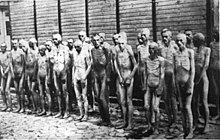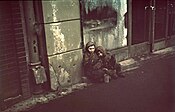
The Final Solution or the Final Solution to the Jewish Question was a Nazi plan for the genocide of individuals they defined as Jews during World War II. The "Final Solution to the Jewish question" was the official code name for the murder of all Jews within reach, which was not restricted to the European continent. This policy of deliberate and systematic genocide starting across German-occupied Europe was formulated in procedural and geopolitical terms by Nazi leadership in January 1942 at the Wannsee Conference held near Berlin, and culminated in the Holocaust, which saw the murder of 90% of Polish Jews, and two-thirds of the Jewish population of Europe.

The Wannsee Conference was a meeting of senior government officials of Nazi Germany and Schutzstaffel (SS) leaders, held in the Berlin suburb of Wannsee on 20 January 1942. The purpose of the conference, called by the director of the Reich Security Main Office SS-Obergruppenführer Reinhard Heydrich, was to ensure the co-operation of administrative leaders of various government departments in the implementation of the Final Solution to the Jewish Question, whereby most of the Jews of German-occupied Europe would be deported to occupied Poland and murdered. Conference participants included representatives from several government ministries, including state secretaries from the Foreign Office, the justice, interior, and state ministries, and representatives from the SS. In the course of the meeting, Heydrich outlined how European Jews would be rounded up and sent to extermination camps in the General Government, where they would be killed.

The General Government, formally the General Governorate for the Occupied Polish Region, was a German zone of occupation established after the invasion of Poland by Nazi Germany, Slovakia and the Soviet Union in 1939 at the onset of World War II. The newly occupied Second Polish Republic was split into three zones: the General Government in its centre, Polish areas annexed by Nazi Germany in the west, and Polish areas annexed by the Soviet Union in the east. The territory was expanded substantially in 1941, after the German Invasion of the Soviet Union, to include the new District of Galicia. The area of the Generalgouvernement roughly corresponded with the Austrian part of the Polish–Lithuanian Commonwealth after the Third Partition of Poland in 1795.

The Generalplan Ost, abbreviated GPO, was Nazi Germany's blueprint for the genocide, extermination and large-scale ethnic cleansing of Slavs, Eastern European Jews, and other indigenous peoples of Eastern Europe categorized as "Untermensch" in Nazi ideology. The campaign was a precursor to Nazi Germany's planned colonisation of Central and Eastern Europe by Germanic settlers, and it was carried out through systematic massacres, mass starvations, chattel labour, mass-rapes, child abductions, and sexual slavery.
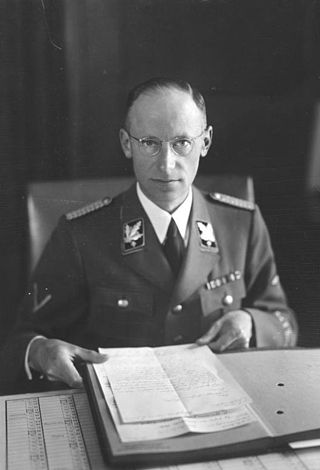
Herbert Friedrich Wilhelm Backe was a German politician and SS Senior group leader (SS-Obergruppenführer) in Nazi Germany who served as State Secretary and Minister in the Reich Ministry of Food and Agriculture. He was a doctrinaire racial ideologue, a long-time associate of Richard Walther Darré and a personal friend of Reinhard Heydrich. He developed and implemented the Operation Hunger that envisioned death by starvation of millions of Slavic and Jewish "useless eaters" following Operation Barbarossa, the 1941 invasion of the Soviet Union.

Georg Thomas was a German general who served during World War II He was a leading participant in planning and carrying out economic exploitation of the Soviet Union, most notably the Hunger Plan. Thomas's role in plotting against Hitler has led some historians to describe him as a member of the German resistance, while others find his record more ambiguous.

Beginning with the invasion of Poland during World War II, the Nazi regime set up ghettos across German-occupied Eastern Europe in order to segregate and confine Jews, and sometimes Romani people, into small sections of towns and cities furthering their exploitation. In German documents, and signage at ghetto entrances, the Nazis usually referred to them as Jüdischer Wohnbezirk or Wohngebiet der Juden, both of which translate as the Jewish Quarter. There were several distinct types including open ghettos, closed ghettos, work, transit, and destruction ghettos, as defined by the Holocaust historians. In a number of cases, they were the place of Jewish underground resistance against the German occupation, known collectively as the ghetto uprisings.

The Holocaust in Poland was the ghettoization, robbery, deportation, and murder of Jews in occupied Poland, organized by Nazi Germany. Three million Polish Jews were murdered, primarily at the Chelmno, Belzec, Sobibor, Treblinka, and Auschwitz II–Birkenau extermination camps, representing half of all Jews murdered during the Europe-wide Holocaust.
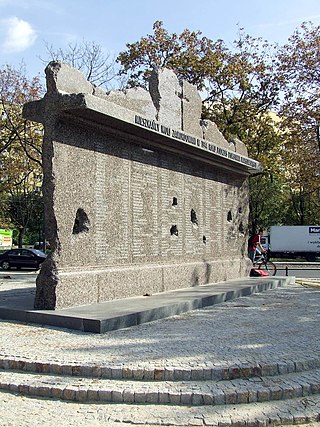
Crimes against the Polish nation committed by Nazi Germany and Axis collaborationist forces during the invasion of Poland, along with auxiliary battalions during the subsequent occupation of Poland in World War II, included the genocide of millions of Polish people, especially the systematic extermination of Jewish Poles. These mass killings were enacted by the Nazis with further plans that were justified by their racial theories, which regarded Poles and other Slavs, and especially Jews, as racially inferior Untermenschen.
Holocaust victims were people targeted by the government of Nazi Germany based on their ethnicity, religion, political beliefs, disability or sexual orientation. The institutionalized practice by the Nazis of singling out and persecuting people resulted in the Holocaust, which began with legalized social discrimination against specific groups, involuntary hospitalization, euthanasia, and forced sterilization of persons considered physically or mentally unfit for society. The vast majority of the Nazi regime's victims were Jews, Sinti-Roma peoples, and Slavs but victims also encompassed people identified as social outsiders in the Nazi worldview, such as homosexuals, and political enemies. Nazi persecution escalated during World War II and included: non-judicial incarceration, confiscation of property, forced labor, sexual slavery, death through overwork, human experimentation, undernourishment, and execution through a variety of methods. For specified groups like the Jews, genocide was the Nazis' primary goal.

The Holocaust was the genocide of European Jews during World War II. Between 1941 and 1945, Nazi Germany and its collaborators systematically murdered some six million Jews across German-occupied Europe, around two-thirds of Europe's Jewish population. The murders were carried out primarily through mass shootings and poison gas in extermination camps, chiefly Auschwitz-Birkenau, Treblinka, Belzec, Sobibor, and Chełmno in occupied Poland.

During World War II, Soviet prisoners of war (POWs) held by Nazi Germany and primarily in the custody of the German Army were starved and subjected to deadly conditions. Of nearly six million that were captured, around three million died during their imprisonment.
The Holocaust in Belarus refers to the systematic extermination of Jews living in the Byelorussian Soviet Socialist Republic during its occupation by Nazi Germany in World War II. It is estimated that roughly 800,000 Belarusian Jews were murdered during the Holocaust. However, other estimates place the number of Jews killed between 500,000 and 550,000.
The Commission for Polish Relief (CPR), also known unofficially as Comporel or the Hoover Commission, was initiated in late 1939 by former US President Herbert Hoover, following the German and Soviet occupation of Poland. The Commission provided relief to Nazi occupied territories of Poland until December 1941.
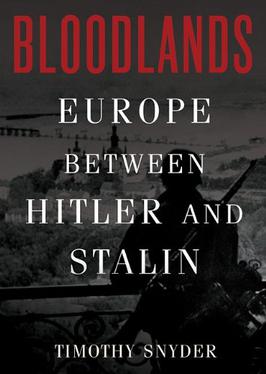
Bloodlands: Europe Between Hitler and Stalin is a 2010 book by Yale historian Timothy Snyder. It is about mass murders committed before and during World War II in territories controlled by Nazi Germany and the Soviet Union.
Alex J. Kay is a British historian who specialises in Nazi Germany. He has been described as "a leading scholar on the Third Reich and German history" and has become prominent above all as a result of his publications on the Hunger Plan and the genocide of Soviet Jewry.

The occupation of Poland by Nazi Germany and the Soviet Union during World War II (1939–1945) began with the Invasion of Poland in September 1939, and it was formally concluded with the defeat of Germany by the Allies in May 1945. Throughout the entire course of the occupation, the territory of Poland was divided between Nazi Germany and the Soviet Union (USSR), both of which intended to eradicate Poland's culture and subjugate its people. In the summer-autumn of 1941, the lands which were annexed by the Soviets were overrun by Germany in the course of the initially successful German attack on the USSR. After a few years of fighting, the Red Army drove the German forces out of the USSR and crossed into Poland from the rest of Central and Eastern Europe.
Hans-Joachim Riecke or Hans-Joachim Ernst Riecke was a German Nazi politician and Gruppenführer in the SS. During World War II Riecke was the State Secretary (Staatssekretär) to Herbert Backe, the Reichsminister of Food and Agriculture. He was Backe's accomplice in planning and implementing the Hunger Plan which resulted in the death by starvation of millions of people in the Soviet Union.

Food - Weapon of Conquest is a 22-minute 1941 Canadian documentary film, made by the National Film Board of Canada (NFB) as part of the wartime Canada Carries On series. The film was written, directed and produced by Stuart Legg. Food - Weapon of Conquest shows the food shortage in Nazi-occupied countries in the Second World War, contrasted with the Allied response to the global food crisis. The film's French version title is Une armée marche sur son estomac.
Food and agriculture in Nazi Germany describes the food and agricultural policies of Nazi Germany and their consequences from 1933 when the Nazis took power in Germany until 1945 when Germany was defeated in World War II (1939–1945) by the allied nations. Starvation and its associated illnesses killed about 20 million people in Europe and Asia during World War II, approximately the same as the number of soldiers killed in battle. Most of the deaths from starvation in Europe were in the Soviet Union and Poland, countries invaded by Germany and occupied in whole or part during the war.

